- With standard equipment
- With safety pack
Find more information in the General Comments section of the assessment
Find more information in the Rating Validity tab of the assessment
- See More
- See More
- See More
- See More
- Good
- Adequate
- Marginal
- Weak
- Poor
 Rear Seat
Rear Seat
 Front Seat
Front Seat
- Good
- Adequate
- Marginal
- Weak
- Poor


Passenger
outboard
center
Fitted to the vehicle as standard
Not fitted to the test vehicle but available as option
Not Available
-
i-Size CRS
-
ISOFIX CRS
-
Universal Belted CRS
Easy
Difficult
Safety critical
Not allowed
| Seat Position | ||||
|---|---|---|---|---|
| Front | 2nd row | |||
| Passenger | Left | center | Right | |
| Maxi Cosi 2way Pearl & 2wayFix (i-Size) | ||||
| Maxi Cosi 2way Pearl & 2wayFix (i-Size) | ||||
| BeSafe iZi Kid X2 i-Size (i-Size) | ||||
| Britax Römer TriFix2 i-Size (i-Size) | ||||
| BeSafe iZi Flex FIX i-Size (i-Size) | ||||
| BeSafe iZi Combi X4 ISOfix (ISOFIX) | ||||
| Cybex Solution Z i-Fix (ISOFIX) | ||||
| Maxi Cosi Cabriofix (Belt) | ||||
| Maxi Cosi Cabriofix & EasyFix (Belt) | ||||
| Britax Römer King II LS (Belt) | ||||
| Cybex Solution Z i-Fix (Belt) | ||||
Easy
Difficult
Safety critical
Not allowed
In the frontal offset test, tensile forces in the neck of the 10 year dummy indicated poor protection of this part of the body. The head and chest of the same dummy were marginally protected. In the side barrier impact, the head of the 10 year old dummy contacted the vehicle interior and protection was rated as poor. The front passenger airbag can be switched off to allow a rearward facing child restraint to be used in that seating position. The installation check on the Group II/III ISOFIX child restraint was deemed a fail owing to conflicting information between the CRS manufacturer and Renault.
- Good
- Adequate
- Marginal
- Weak
- Poor

Head Impact 14.2 Pts
Pelvis Impact 1.9 Pts
Leg Impact 6.0 Pts
The protection provided by the bonnet to the head of a struck pedestrian was predominantly good or adequate, with poor results recorded on the still windscreen pillars. The bumper provided good protection to pedestrian's legs at all test positions. However, protection of the pelvis was almost entirely poor. An autonomous emergency braking (AEB) system is available which can react to vulnerable road users like pedestrians and cyclists. However, this system is an option so was not tested as part of this assessment.
- Good
- Adequate
- Marginal
- Weak
- Poor
| System Name | Speed limiter |
| Speed Control Function | Manually set (accurate to 5km/h) |
| Applies To | Front and third row seats | ||
| Warning | Driver Seat | Front Passenger(s) | Rear Passenger(s) |
| Visual | |||
| Audible | |||
| Occupant Detection | |||
|
|||
A seatbelt reminder system is standard for all seats and the Zoe but the vehicle lacks a fatigue-detection system. Lane assistance is available as an option and was not assessed here. The AEB system is also optional and excluded from this assessment. A driver-set speed limiter is standard.
- Specifications
- Safety Equipment
- Videos
- Rating Validity
Specifications
Tested Model Renault Zoe 80 kW electric 'ZEN', LHD
Body Type - 5 door hatchback
Year Of Publication 2021
Kerb Weight 1563kg
VIN From Which Rating Applies - all Zoes
Class City and Supermini
Safety Equipment
Note: Other equipment may be available on the vehicle but was not considered in the test year.
Fitted to the vehicle as standard
Fitted to the vehicle as part of the safety pack
Not fitted to the test vehicle but available as option or as part of the safety pack
Not available
Not applicable
Videos
Rating Validity
Variants of Model Range
| Body Type | Engine | Model Name | Drivetrain | Rating Applies | |
|---|---|---|---|---|---|
| LHD | RHD | ||||
| 5 door hatchback | 80 kW electric | LIFE 41 kWh | 4 x 2 |  |
 |
| 5 door hatchback | 80 kW electric | ZEN* | 4 x 2 |  |
 |
| 5 door hatchback | 100 kW electric | ZEN | 4 x 2 |  |
 |
| 5 door hatchback | 100 kW electric | INTENS | 4 x 2 |  |
 |
| 5 door hatchback | 80 kW electric | LIFE 50 kWh | 4 x 2 |  |
 |
* Tested variant

Find more information in the General Comments section of the assessment
 Share
Share
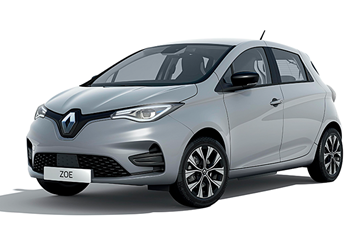
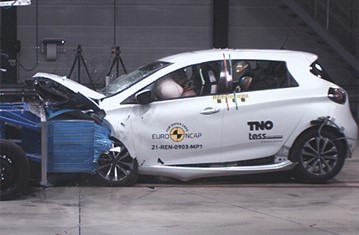
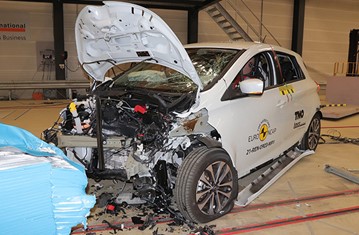
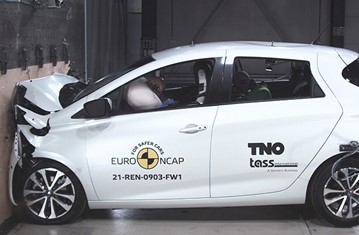
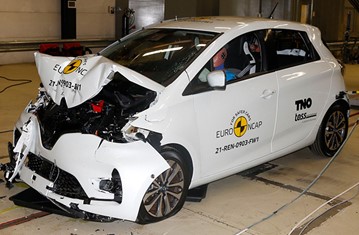












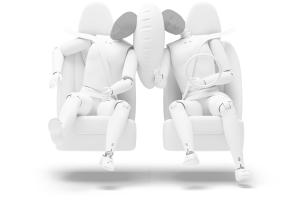

The passenger compartment of the Zoe remained stable in the frontal offset test. Readings of the passenger dummy’s left knee slide were high in comparison with recommended limits. This, combined with the penalty incurred for structures in the dashboard which might be hazard to occupants of different sizes, led to protection of this part of the being rated as poor. Protection of the driver’s chest was rated as weak, based on dummy readings of chest compression during the test. Analysis of the deceleration of the impact trolley during the test, and of the deformation of the barrier afterwards, revealed that the Zoe would be a moderately aggressive crash partner to other vehicles. In the full width rigid barrier test, the head of the rear passenger was penalised for the extent to which it moved forward, and protection was rated as marginal. Chest protection of the rear dummy was also rated as marginal, based on measurements of compression. In the side barrier test, protection of all critical body regions was good and the Zoe scored maximum points in this part of the assessment. The film shows the dummy’s arm becoming detached during the test. This breakage is thought to have been caused by earlier damage to the dummy and is not related to any characteristic of the Zoe itself. Comparison with other test results indicated that dummy readings were similar. However, in the more severe side pole impact, driver’s head directly impacted the intruding pole and head injury values indicated poor protection of this part of the body. Rib compression indicated marginal chest protection. The Zoe is not equipped with a centre airbag to protect against occupant to occupant injuries in side impacts. Tests on the front seats and head restraints demonstrated marginal protection against whiplash injures in the event of a rear-end collision. A geometric assessment of the rear seats indicated poor whiplash protection. The Zoe has neither an advanced eCall system nor multi-collision braking to prevent secondary impacts.